Suprapubic catheter
| Suprapubic catheter | |
|---|---|
| Other names: Suprapubic cystostomy, vesicostomy, epicystostomy | |
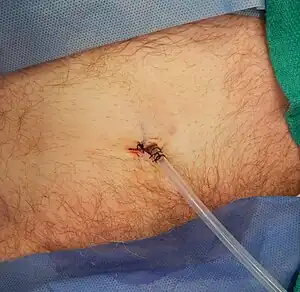 | |
| A newly placed suprapubic catheter entering the abdomen just above the pubic bone | |
| Specialty | Urology, emergency medicine |
| Indications | Urinary obstruction[1] |
| Contraindications | Empty bladder, bladder cancer[1] |
| Steps | 1) Verify the bladder is full 2) Shave, sterilize, and freeze the area 3) Two finger widths above the pubic bone insert a needle until urine returns 4) Place a guidewire through the needle, than remove the needle 5) Pass a dilator and sheath over the wire 6) Remove the wire and dilator 7) Place the catheter through the sheath and inflate the balloon[1][2] |
| Complications | Bleeding, bowel injury, infection, urine leakage[1] |
A suprapubic catheter (SPC) is a drainage tube placed into the urinary bladder just above the pubic symphysis.[1] This is generally done for urinary obstruction when other methods are not possible.[1] Other options may include urethral catheterization and intermittent catheterization.[1]
Before beginning it should be verified by ultrasound that the bladder is full.[1] The area is than shaved, sterilized, and frozen.[1] In the Seldinger technique, about two finger widths above the pubic bone a needle is inserted until urine returns.[1] A guidewire is than inserted through the needle and the needle removed.[1] A dilator and sheath is than passed over the wire after which the dilator and wire is removed.[1] A Foley catheter is than inserted through the sheath.[2] The procedure may also be done with an open technique or a trocar.[1]
After the procedure the Foley is inflated with 10 ml and some gentle traction is applied.[2] It is than secured in place.[1] Complications may include bleeding, bowel injury, infection, and urine leakage around the catheter site.[1] The procedure is done relatively frequently.[3] If a specific kit is not avaliable, a central line may be used.[2]
Medical uses
- Failed urethral catheter,
- Long term usage (if left in urethral long terms catheters can lead to acquired hypospadias and recurrent/chronic UTIs, urinary tract infections).
Obstruction may occur due to an enlarged prostate, traumatic disruption of the urethra, congenital defects of the urinary tract, blockage by kidney stones, or cancer. It is also used in people with spinal cord injury who are unable or unwilling to use intermittent catheterization to empty the bladder, and cannot otherwise void due to detrusor sphincter dyssynergia.
Contraindications
The procedure cannot be done if the bladder is not full.[2] Greater care is required in those who have had previous lower abdominal surgery or who have a bleeding disorder.[2]
Technique
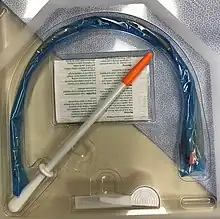
Preparation
Verify the bladder is full.[1]
Steps
- Shave, sterilize, and freeze the area.[1]
- One to two finger widths above the pubic bone insert a needle until urine returns.[1][2]
- Place a guidewire through the needle, than remove the needle.[1]
- Pass a dilator and sheath over the wire.[1]
- Pass a Foley through the sheath and peel the sheath away.[2]
- Inflate the Foley balloon with 10 ml to make it harder to accidentally remove.[2]
- Gentle apply some traction and secure the catheter into place.[2][1]
Post-procedure
The catheter may than be attached to a drainage bag as normal.[2]
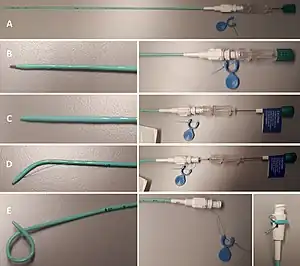 Various settings of a 6 French pigtail catheter with locking string, obturator (also called stiffening cannula) and puncture needle.
Various settings of a 6 French pigtail catheter with locking string, obturator (also called stiffening cannula) and puncture needle.
A. Overview
B. Both obturator and puncture needle engaged.
C. Puncture needle retracted. Obturator engaged.
D. Both obturator and puncture needle retracted.
E. Locking string is pulled (bottom center) and then wrapped and attach to the superficial end of the catheter.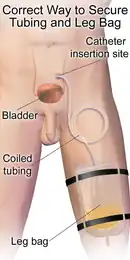 Drawing of thet way to secure the tubing and leg bag of a suprapubic catheter on a male.
Drawing of thet way to secure the tubing and leg bag of a suprapubic catheter on a male.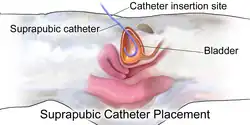 Drawing of the placement of a suprapubic catheter in a female. Actual placement should be just over the pubic bone.
Drawing of the placement of a suprapubic catheter in a female. Actual placement should be just over the pubic bone. Depiction of the proper way to clean around a suprapubic catheter.
Depiction of the proper way to clean around a suprapubic catheter.
Complications
- Urinary tract infection
- Blockage
- Bladder stones[4]
- Bladder cancer
- Urine leakage around the catheter
Society and culture
The "suprapubic cystotomy" is a specialty of the fictional physician Stephen Maturin in Patrick O'Brian's twenty-one volume series on the Royal Navy during the Napoleonic era.[5] In modern medical terminology, "cystotomy" without the "s" refers to any surgical incision or puncture into the bladder, such as to remove urinary calculi or to perform tissue repair and reconstruction. "Cystostomy" is surgery specifically to provide drainage.[6]
See also
- List of surgeries by type
- Bonanno catheter, originally designed for suprapubic cystostomy
References
- 1 2 3 4 5 6 7 8 9 10 11 12 13 14 15 16 17 18 19 20 21 Corder, CJ; LaGrange, CA (January 2021). "Suprapubic Bladder Catheterization". PMID 29489238.
{{cite journal}}: Cite journal requires|journal=(help) - 1 2 3 4 5 6 7 8 9 10 11 Roberts and Hedges' clinical procedures in emergency medicine and acute care (Seventh ed.). Philadelphia, PA: Elsevier Health Sciences. 2019. p. 1172. ISBN 9780323547949.
- ↑ Jacob, P; Rai, BP; Todd, AW (September 2012). "Suprapubic catheter insertion using an ultrasound-guided technique and literature review". BJU International. 110 (6): 779–84. doi:10.1111/j.1464-410X.2011.10882.x. PMID 22257272.
- ↑ Suzanne C. Smeltzer (2010). Brunner & Suddarth's textbook of medical-surgical nursing (12th ed.). Philadelphia: Wolters Kluwer Health/Lippincott Williams & Wilkins. p. 1373. ISBN 9780781785891. Archived from the original on 2021-08-29. Retrieved 2017-09-15.
- ↑ O'Brian, Patrick (1998). The Hundred Days (Aubrey/Maturin Series). New York: W.W. Norton & Company. p. 47. ISBN 0-393-31979-2.
- ↑ "National Library of Medicine - Medical Subject Headings". Archived from the original on 2016-08-15. Retrieved 2016-08-16.
External links
- Cystostomy description Archived 2017-07-06 at the Wayback Machine
- Vesicostomy care of infants and children Archived 2007-09-28 at the Wayback Machine
| Classification |
|---|